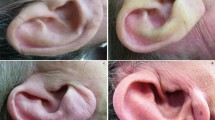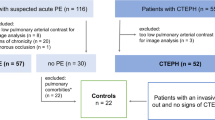Abstract
Objectives
This study aimed to develop non-invasive machine learning classifiers for predicting post–Glenn shunt patients with low and high risks of a mean pulmonary arterial pressure (mPAP) > 15 mmHg based on preoperative cardiac computed tomography (CT).
Methods
This retrospective study included 96 patients with functional single ventricle who underwent a bidirectional Glenn procedure between November 1, 2009, and July, 31, 2017. All patients underwent post-procedure CT, followed by cardiac catheterization. Overall, 23 morphologic parameters were manually extracted from cardiac CT images for each patient. The Mann-Whitney U or chi-square test was applied to select the most significant predictors. Six machine learning algorithms including logistic regression, Naive Bayes, random forest (RF), linear discriminant analysis, support vector machine, and K-nearest neighbor were used for modeling. These algorithms were independently trained on 100 train-validation random splits with a 3:1 ratio. Their average performance was evaluated by area under the curve (AUC), accuracy, sensitivity, and specificity.
Results
Seven CT morphologic parameters were selected for modeling. RF obtained the best performance, with mean AUC of 0.840 (confidence interval [CI] 0.832–0.850) and 0.787 (95% CI 0.780–0.794); sensitivity of 0.815 (95% CI 0.797–0.833) and 0.778 (95% CI 0.767–0.788), specificity of 0.766 (95% CI 0.748–0.785) and 0.746 (95% CI 0.735–0.757); and accuracy of 0.782 (95% CI 0.771–0.793) and 0.756 (95% CI 0.748–0.764) in the training and validation cohorts, respectively.
Conclusions
The CT-based RF model demonstrates a good performance in the prediction of mPAP, which may reduce the need for right heart catheterization in post–Glenn shunt patients with suspected mPAP > 15 mmHg.
Key Points
• Twenty-three candidate descriptors were manually extracted from cardiac computed tomography images, and seven of them were selected for subsequent modeling.
• The random forest model presents the best predictive performance for pulmonary pressure among all methods.
• The computed tomography–based machine learning model could predict post–Glenn shunt pulmonary pressure non-invasively.


Similar content being viewed by others
Abbreviations
- AAN:
-
Anastomosis area
- AIVC:
-
Inferior vena cava area
- ALPA:
-
Left pulmonary artery area
- APAbAN:
-
Area of pulmonary artery below anastomosis
- ARPA:
-
Right pulmonary artery area
- ASVC:
-
Superior vena cava area
- AUC:
-
Area under the curve
- CI:
-
Confidence interval
- CT:
-
Computed tomography
- DANMA:
-
Diameter of anastomosis major axis
- DANMI:
-
Diameter of anastomosis minor axis
- DIVCMA:
-
Diameter of inferior vena cava major axis
- DIVCMI:
-
Diameter of inferior vena cava minor axis
- DPAMAbAN:
-
Diameter of pulmonary artery major axis below anastomosis
- DSVCMA:
-
Diameter of superior vena cava major axis
- DSVCMI:
-
Diameter of superior vena cava minor axis
- MAPCAs:
-
Major aortopulmonary collateral arteries
- mPAP:
-
Mean pulmonary arterial pressure
- PAN:
-
Anastomosis perimeter
- PIVC:
-
Inferior vena cava perimeter
- PSVC:
-
Superior vena cava perimeter
- RF:
-
Random forest
References
Tanoue Y, Kado H, Boku N et al (2007) Three hundred and thirty-three experiences with the bidirectional Glenn procedure in a single institute. Interact Cardiovasc Thorac Surg 6:97–101
Hosein RB, Clarke AJ, McGuirk SP et al (2007) Factors influencing early and late outcome following the Fontan procedure in the current era. The ‘Two Commandments?’. Eur J Cardiothorac Surg 31:344–352
Stern HJ (2010) Fontan “Ten Commandments” revisited and revised. Pediatr Cardiol 31:1131–1134
Mandel J, Poch D (2013) In the clinic. Pulmonary hypertension. Ann Intern Med 158:C1–C5
Hoeper MM, Lee SH, Voswinckel R et al (2006) Complications of right heart catheterization procedures in patients with pulmonary hypertension in experienced centers. J Am Coll Cardiol 48:2546–2552
Stern KW, McElhinney DB, Gauvreau K, Geva T, Brown DW (2011) Echocardiographic evaluation before bidirectional Glenn operation in functional single-ventricle heart disease: comparison to catheter angiography. Circ Cardiovasc Imaging 4:498–505
Shen Y, Wan C, Tian P et al (2014) CT-base pulmonary artery measurement in the detection of pulmonary hypertension: a meta-analysis and systematic review. Medicine (Baltimore) 93:e256
Janda S, Shahidi N, Gin K, Swiston J (2011) Diagnostic accuracy of echocardiography for pulmonary hypertension: a systematic review and meta-analysis. Heart 97:612–622
Wang N, Hu X, Liu C et al (2014) A systematic review of the diagnostic accuracy of cardiovascular magnetic resonance for pulmonary hypertension. Can J Cardiol 30:455–463
Chen X, Liu K, Wang Z et al (2015) Computed tomography measurement of pulmonary artery for diagnosis of COPD and its comorbidity pulmonary hypertension. Int J Chron Obstruct Pulmon Dis 10:2525–2533
Rajaram S, Swift AJ, Condliffe R et al (2015) CT features of pulmonary arterial hypertension and its major subtypes: a systematic CT evaluation of 292 patients from the ASPIRE Registry. Thorax 70:382–387
Grosse C, Grosse A (2010) CT findings in diseases associated with pulmonary hypertension: a current review. Radiographics 30:1753–1777
Abel E, Jankowski A, Pison C, Luc Bosson J, Bouvaist H, Ferretti GR (2012) Pulmonary artery and right ventricle assessment in pulmonary hypertension: correlation between functional parameters of ECG-gated CT and right-side heart catheterization. Acta Radiol 53:720–727
Siegel Y, Mirpuri T (2014) Pulmonary hypertension detection using dynamic and static measurable parameters on CT angiography. J Comput Assist Tomogr 38:586–590
Mahammedi A, Oshmyansky A, Hassoun PM, Thiemann DR, Siegelman SS (2013) Pulmonary artery measurements in pulmonary hypertension: the role of computed tomography. J Thorac Imaging 28:96–103
Goldstein BA, Navar AM, Carter RE (2017) Moving beyond regression techniques in cardiovascular risk prediction: applying machine learning to address analytic challenges. Eur Heart J 38:1805–1814
Krittanawong C, Zhang H, Wang Z, Aydar M, Kitai T (2017) Artificial intelligence in precision cardiovascular medicine. J Am Coll Cardiol 69:2657–2664
Henglin M, Stein G, Hushcha PV, Snoek J, Wiltschko AB, Cheng S (2017) Machine learning approaches in cardiovascular imaging. Circ Cardiovasc Imaging 10:e005614. https://doi.org/10.1161/CIRCIMAGING.117.005614
Darcy AM, Louie AK, Roberts LW (2016) Machine learning and the profession of medicine. JAMA 315:551–552
Hae H, Kang SJ, Kim WJ et al (2018) Machine learning assessment of myocardial ischemia using angiography: development and retrospective validation. PLoS Med 15:e1002693
Liu H, Juan YH, Wang Q et al (2014) Evaluation of malposition of the branch pulmonary arteries using cardiovascular computed tomography angiography. Eur Radiol 24:3300–3307
Yagi M, Taniguchi H, Kondoh Y et al (2017) CT-determined pulmonary artery to aorta ratio as a predictor of elevated pulmonary artery pressure and survival in idiopathic pulmonary fibrosis. Respirology 22:1393–1399
Nakata S, Imai Y, Takanashi Y et al (1984) A new method for the quantitative standardization of cross-sectional areas of the pulmonary arteries in congenital heart diseases with decreased pulmonary blood flow. J Thorac Cardiovasc Surg 88:610–619
Fiore AC, Tobin C, Jureidini S, Rahimi M, Kim ES, Schowengerdt K (2011) A comparison of the modified Blalock-Taussig shunt with the right ventricle-to-pulmonary artery conduit. Ann Thorac Surg 91:1479–1484 1484–1485
Jia Q, Cen J, Zhuang J et al (2017) Significant survival advantage of high pulmonary vein index and the presence of native pulmonary artery in pulmonary atresia with ventricular septal defect and major aortopulmonary collateral arteries: results from preoperative computed tomography angiography. Eur J Cardiothorac Surg 52:225–232
Maeda E, Akahane M, Kato N et al (2006) Assessment of major aortopulmonary collateral arteries with multidetector-row computed tomography. Radiat Med 24:378–383
Deo RC (2015) Machine Learning in Medicine. Circulation 132:1920–1930
Zhang Y, Zhang B, Liang F et al (2019) Radiomics features on non-contrast-enhanced CT scan can precisely classify AVM-related hematomas from other spontaneous intraparenchymal hematoma types. Eur Radiol 29:2157–2165
Ciritsis A, Rossi C, Eberhard M, Marcon M, Becker AS, Boss A (2019) Automatic classification of ultrasound breast lesions using a deep convolutional neural network mimicking human decision-making. Eur Radiol. https://doi.org/10.1007/s00330-019-06118-7
Lungu A, Swift AJ, Capener D, Kiely D, Hose R, Wild JM (2016) Diagnosis of pulmonary hypertension from magnetic resonance imaging-based computational models and decision tree analysis. Pulm Circ 6:181–190
Dawes T, de Marvao A, Shi W et al (2017) Machine learning of three-dimensional right ventricular motion enables outcome prediction in pulmonary hypertension: a cardiac MR imaging study. Radiology 283:381–390
Dennis A, Michaels AD, Arand P, Ventura D (2010) Noninvasive diagnosis of pulmonary hypertension using heart sound analysis. Comput Biol Med 40:758–764
Elgendi M, Bobhate P, Jain S et al (2018) The voice of the heart: vowel-like sound in pulmonary artery hypertension. Diseases 6:E26. https://doi.org/10.3390/diseases6020026
Diller GP, Kempny A, Babu-Narayan SV, et al (2019) Machine learning algorithms estimating prognosis and guiding therapy in adult congenital heart disease: data from a single tertiary centre including 10 019 patients. Eur Heart J 40:1069–1077
Zhang B, He X, Ouyang F et al (2017) Radiomic machine-learning classifiers for prognostic biomarkers of advanced nasopharyngeal carcinoma. Cancer Lett 403:21–27
Nagasawa S, Al-Naamani E, Saeki A (2018) Computer-aided screening of conjugated polymers for organic solar cell: classification by random forest. J Phys Chem Lett 9:2639–2646
Yao Y, Li X, Liao B et al (2017) Predicting influenza antigenicity from Hemagglutintin sequence data based on a joint random forest method. Sci Rep 7:1545
Eshaghi A, Wottschel V, Cortese R et al (2016) Gray matter MRI differentiates neuromyelitis optica from multiple sclerosis using random forest. Neurology 87:2463–2470
Gray KR, Aljabar P, Heckemann RA, Hammers A, Rueckert D (2013) Random forest-based similarity measures for multi-modal classification of Alzheimer’s disease. Neuroimage 65:167–175
Esmaily-Moghadam M, Hsia TY, Marsden AL (2015) The assisted bidirectional Glenn: a novel surgical approach for first-stage single-ventricle heart palliation. J Thorac Cardiovasc Surg 149:699–705
Funding
This study was supported by the Key Program of Union of National Natural Science Foundation of China-Guangdong Province (U1401255), the Natural Science Foundation of Guangdong Province (2018A030313785), the Science and Technology Planning Project of Guangdong Province (2019B020230003, 2018B090944002, 2017A070701013, 2017B090904034, and 2017B030314109), the National key Research and Development Program (2018YFC1002600), and Guangdong peak project (DFJH201802).
Author information
Authors and Affiliations
Corresponding authors
Ethics declarations
Guarantor
The scientific guarantor of this publication is Yuhao Dong.
Conflict of interest
The authors of this manuscript declare no relationships with any companies whose products or services may be related to the subject matter of the article.
Statistics and biometry
The author Dewen Zeng did statistical analyses.
Informed consent
Written informed consent was waived from all subjects (patients) in this study.
Ethical approval
Institutional Review Board approval was obtained.
Methodology
• Retrospective
• Diagnostic study or prognostic
• Performed at one institution
Additional information
Publisher’s note
Springer Nature remains neutral with regard to jurisdictional claims in published maps and institutional affiliations.
Rights and permissions
About this article
Cite this article
Huang, L., Li, J., Huang, M. et al. Prediction of pulmonary pressure after Glenn shunts by computed tomography–based machine learning models. Eur Radiol 30, 1369–1377 (2020). https://doi.org/10.1007/s00330-019-06502-3
Received:
Revised:
Accepted:
Published:
Issue Date:
DOI: https://doi.org/10.1007/s00330-019-06502-3




